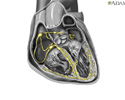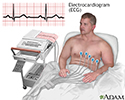His bundle electrography
His bundle electrogram; HBE; His bundle recording; Electrogram - His bundle; Arrhythmia - His; Heart block - His
His bundle electrography is a test that measures electrical activity in a part of the heart that carries the signals that control the time between heartbeats (contractions).
How the Test is Performed
The bundle of His is a group of fibers that carry electrical impulses through the center of the heart. If these signals are blocked, you will have problems with your heartbeat.
The His bundle electrography is part of an electrophysiology study (EPS). An intravenous catheter (IV line) is inserted into your arm so that you can be given medicines during the test.
Electrocardiogram (ECG) leads are placed on your arms and legs. Your arm, neck, or groin will be cleaned and numbed with a local anesthetic. After the area is numb, the cardiologist (heart doctor) makes a small cut in a vein and inserts a thin tube called a catheter inside.
The catheter is carefully moved through the vein up into the heart. An x-ray method called fluoroscopy helps guide the doctor to the right place. During the test, you are watched for any abnormal heartbeats (arrhythmias). The catheter has a sensor on the end, which is used to measure the electrical activity of the bundle of His.
How to Prepare for the Test
You will be told not to eat or drink anything for 6 to 8 hours before the test. The test will be done in a hospital. Some people may need to check into the hospital the night before the test. Otherwise, you will check in the morning of the test. Although the test may take some time, most people do not need to stay in the hospital overnight.
Your health care provider will explain the procedure and its risks. You must sign a consent form before the test starts.
About half an hour before the procedure, you will be given a mild sedative to help you relax. You will wear a hospital gown. The procedure may last from 1 to several hours.
How the Test will Feel
You are awake during the test. You may feel some discomfort when the IV is placed into your arm, and some pressure at the site when the catheter is inserted.
Why the Test is Performed
This test may be done to:
- Determine if you need a pacemaker or other treatment
- Diagnose arrhythmias
- Find the specific location where electrical signals through the heart are blocked
Normal Results
The time it takes for the electrical signals to travel through the bundle of His is normal.
What Abnormal Results Mean
A pacemaker may be needed if the test results are abnormal.
Risks
Risks of the procedure include:
- Arrhythmias
- Cardiac tamponade
- Embolism from blood clots at the tip of the catheter
- Heart attack
- Hemorrhage
- Infection
- Injury to the vein or artery
- Low blood pressure
- Stroke
References
Curtis AB, Tomaselli GF. Approach to the patient with cardiac arrhythmias. In: Libby P, Bonow RO, Mann DL, Tomaselli GF, Bhatt DL, Solomon SD, eds. Braunwald's Heart Disease: A Textbook of Cardiovascular Medicine. 12th ed. Philadelphia, PA: Elsevier; 2022:chap 61.
Issa ZF, Miller JM, Zipes DP. Atrioventricular conduction abnormalities. In: Issa ZF, Miller JM, Zipes DP, eds. Clinical Arrhythmology and Electrophysiology: A Companion to Braunwald's Heart Disease. 4th ed. Philadelphia, PA: Elsevier; 2024:chap 10.
Review Date: 5/8/2024
Reviewed By: Thomas S. Metkus, MD, Assistant Professor of Medicine and Surgery, Johns Hopkins University School of Medicine, Baltimore, MD. Also reviewed by David C. Dugdale, MD, Medical Director, Brenda Conaway, Editorial Director, and the A.D.A.M. Editorial team.










